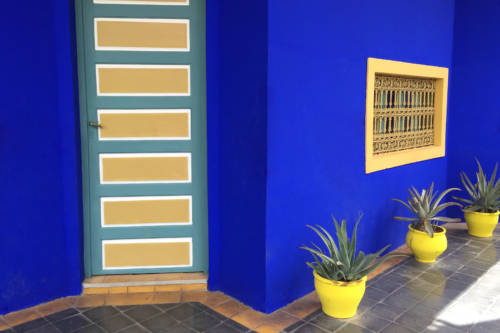
The History of Jardin Majorelle, The Marrakech Garden That Transfixed Yves Saint-Laurent
Far from the madding crowds at Djemaa el Fna square, whose night market is a constant chaotic spectacle of snake-charmers, monkey handlers, potion peddlers and food vendors, Jardin Majorelle is a tranquil garden in Marrakech created by a Morocco-loving French painter, Jacques Majorelle, and preserved by another Frenchman: fashion designer Yves Saint-Laurent.
The garden’s fame far eclipsed paintings by Majorelle, who lived and worked here from 1923-1961. His name also lives on in the electric cobalt-blue of its structures, which he patented as “Majorelle bleu.” Besides the brilliant blue, lemon-yellow, and pumpkin-orange clay pots, a mint-green pavilion with white carved stucco trim and benches provide intense pops of color on a stroll past the many plants, ponds and fountains.
Majorelle called this masterpiece his “most beautiful work,” noting that he had “given it all my love.”
Saint-Laurent praised the garden as a “constant source of inspiration,” saying he even dreamed about its vibrant colors. “We were seduced by this oasis where the colors of Matisse were mixed with those of nature,” the late Algeria-born fashion designer’s partner, Pierre Berge, wrote in [easyazon_link identifier=”2732445029″ locale=”US” tag=”gardcoll03-20″]Une passion marocaine[/easyazon_link] in 2010. Palms, bamboo thickets, cacti, bougainvillea, jasmine, water lilies, agaves, weeping willows, Datura and Thuja evergreens fill the garden in the Ville-Nouvelle district of Marrakech, named Gueliz. As dusk falls, the garden, which draws almost 800,000 visitors a year, comes alive with the sounds of Oriental nightingales, collared doves and croaking frogs, as well as splashing fountains.
Majorelle, the son of well-known furniture designer Louis Majorelle, was born in 1886 in Nancy, and raised in artistic circles when Art Nouveau– then inspired by shapes found in nature– was in vogue. After studying art in Paris, Majorelle visited Morocco, whose colors and light mesmerized him. Moving to Marrakech in 1919 with his wife, he purchased four acres of land in 1923 where he built his Moorish-style villa, a studio in Berber style (harkening to the indigenous people of Morocco), where he began a garden. Approaching it like a painting, he grouped species between light and shadow around a long narrow central basin and irregular paths. During his travels, he brought home plants from all over the world, corresponded with fellow passionate gardeners worldwide, and amassed a total of 10 acres to have more space.
Saint-Laurent praised the garden as a “constant source of inspiration,” saying he even dreamed about its vibrant colors.
Starting to use “Majorelle bleu” in 1937, he first painted the façade of his studio, and later gates, pergolas, pots and other buildings in cobalt and other vivid primary colors. He also painted a ceiling with motifs from Berber art in a restaurant in La Mamounia, the grand 1920’s luxury hotel that Winston Churchill called “the most beautiful place in the world.” (Today, his ceiling is in a grand hall next to a bar in the hotel, which was re-designed by celebrity designer Jacques Garcia.)
Since the garden was costly to maintain, Majorelle opened it to the public in 1947. Sadly, after his 1956 divorce, he was forced to sell off the property piece by piece. After a severe car accident, he went for medical treatment in the last year of his life to Paris, where he died in 1962. The garden was abandoned.
After saving the garden and villa from demolition for a new hotel, Saint-Laurent bought them in 1980 with his partner, Pierre Berge. Restoring the garden “by respecting the vision of Jardin Majorelle,” Saint-Laurent increased its number of plant species to 300 from 135, and installed automatic irrigation systems pegged to certain times and the needs of each plant. He and Berge lived in the villa, renamed Villa Oasis, which they decorated as an Orientalist fantasy, and turned Majorelle’s studio into a museum of Islamic art pieces that they collected, from vases and jewelry to swords.
After Saint-Laurent died in 2008, Berge donated the garden and villa to the Paris-based foundation named for both of them. The street in front of the Jardin Majorelle was renamed Rue Yves Saint-Laurent in 2010, and its dedication and sign were attended by the Culture Ministers of both France and Morocco. The pair’s Islamic museum was converted to a museum of Berber art the next year, as their Islamic art collection was sold to fund the garden and other projects, such as an Yves Saint-Laurent Museum expected to open in late 2017 in a new cultural center near the garden.
For more information on Jardin Majorelle, visit the garden’s website.











































